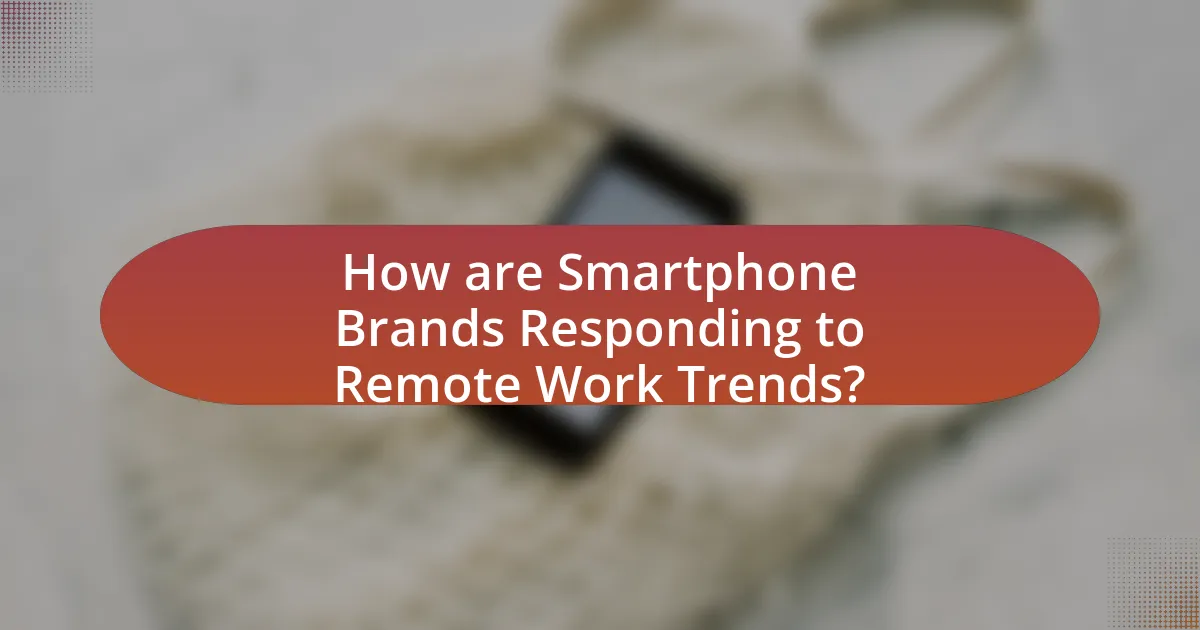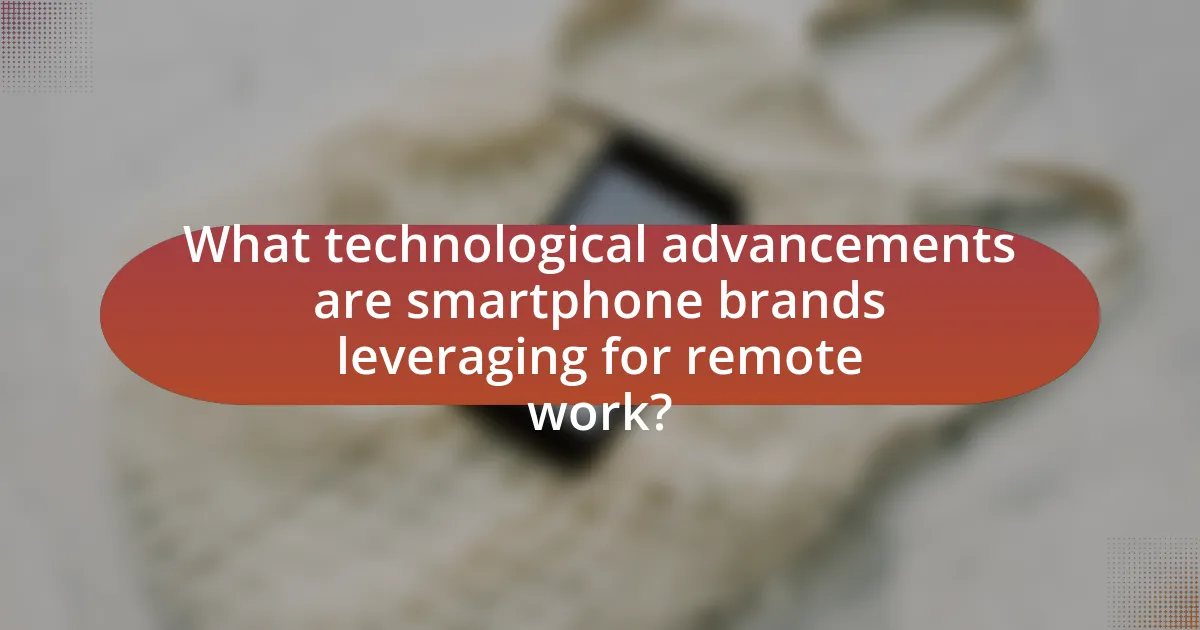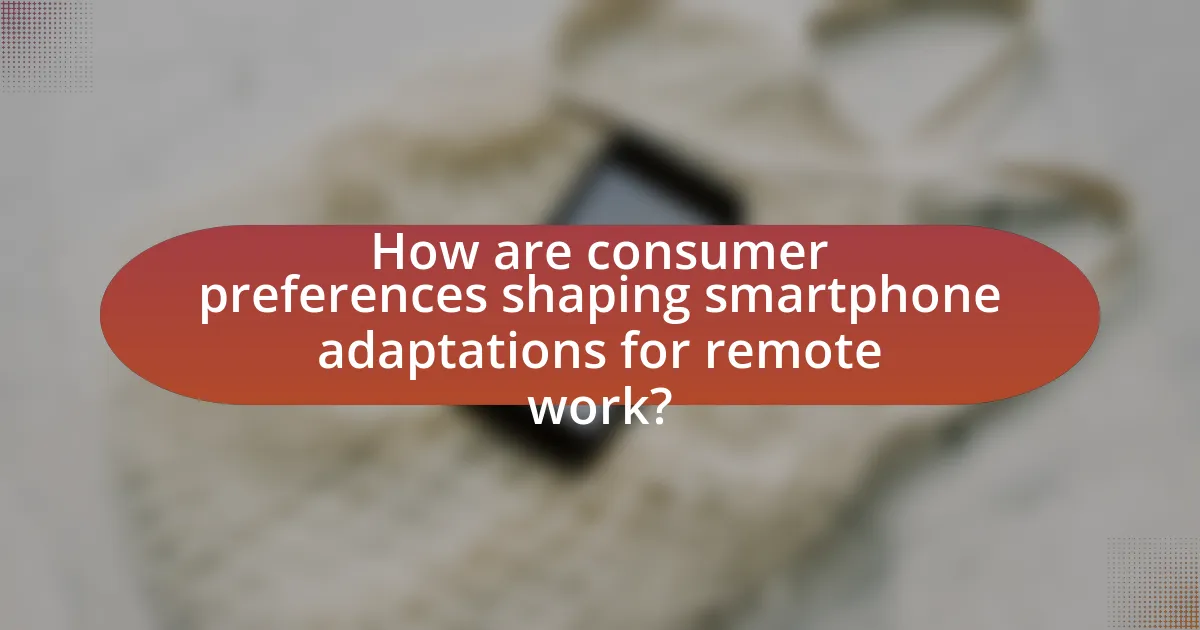Smartphone brands are adapting to the increasing prevalence of remote work by enhancing device capabilities that support productivity and connectivity. Key trends influencing these adaptations include the demand for improved multitasking, enhanced security measures, and the rise of 5G technology. Brands like Apple and Samsung are integrating features such as advanced video conferencing capabilities, longer battery life, and productivity applications to meet the needs of remote workers. Additionally, consumer preferences are shaping product development, with a focus on high-quality cameras and robust security features. The article explores how these adaptations reflect the evolving landscape of remote work and the strategies brands are implementing to remain competitive in this market.

How are Smartphone Brands Responding to Remote Work Trends?
Smartphone brands are responding to remote work trends by enhancing device capabilities that support productivity and connectivity. Companies like Apple and Samsung have introduced features such as improved multitasking, enhanced video conferencing capabilities, and optimized battery life to cater to the needs of remote workers. For instance, Apple’s iPhone 13 series includes features like Cinematic mode for better video calls, while Samsung’s Galaxy devices offer DeX mode, allowing users to connect their phones to larger displays for a desktop-like experience. These adaptations are driven by the increasing demand for devices that facilitate seamless communication and collaboration in a remote work environment.
What are the key remote work trends influencing smartphone brands?
Key remote work trends influencing smartphone brands include the increasing demand for productivity features, enhanced security measures, and the rise of 5G connectivity. As remote work becomes more prevalent, smartphone brands are prioritizing devices that support multitasking and productivity applications, such as improved battery life and larger screens. Additionally, with the rise in cyber threats, brands are integrating advanced security features like biometric authentication and encrypted communications. The adoption of 5G technology is also crucial, as it enables faster internet speeds and better connectivity for remote workers, facilitating seamless video conferencing and collaboration. These trends reflect the evolving needs of remote workers and drive smartphone brands to innovate accordingly.
How has the increase in remote work affected smartphone usage patterns?
The increase in remote work has significantly elevated smartphone usage patterns, with users relying more on their devices for communication, productivity, and entertainment. A study by Deloitte in 2021 found that 70% of remote workers reported increased smartphone usage for work-related tasks, such as video conferencing and collaboration apps. Additionally, the demand for mobile applications that facilitate remote work has surged, leading to a 25% increase in downloads of productivity apps during the pandemic. This shift indicates that smartphones have become essential tools for managing work-life balance in a remote environment.
What specific features are becoming more important for remote workers?
Specific features becoming more important for remote workers include enhanced battery life, high-quality cameras, and robust security measures. Enhanced battery life is crucial as remote workers often rely on their devices for extended periods without access to charging. High-quality cameras facilitate effective virtual communication, which is essential for remote collaboration. Robust security measures protect sensitive information, as remote work increases exposure to cybersecurity threats. According to a report by Gartner, 88% of organizations have encouraged or required employees to work from home, highlighting the need for these features in smartphones to support remote work effectively.
Why are smartphone brands focusing on remote work solutions?
Smartphone brands are focusing on remote work solutions to meet the increasing demand for mobile productivity tools. The shift to remote work has accelerated due to the COVID-19 pandemic, with a significant rise in the number of employees working from home; for instance, a Stanford study found that 42% of the U.S. workforce was working remotely full-time as of mid-2020. This trend has prompted smartphone manufacturers to enhance their devices with features that support remote collaboration, such as improved camera quality for video conferencing, better battery life for extended use, and software integrations that facilitate seamless communication and project management. By prioritizing these solutions, brands aim to capture a growing market segment that values flexibility and efficiency in their work environments.
What market demands are driving this focus?
The market demands driving the focus on how smartphone brands are adapting to remote work trends include the increasing need for enhanced connectivity, productivity tools, and versatile device functionality. As remote work becomes more prevalent, consumers require smartphones that support seamless communication and collaboration, leading to a surge in demand for devices with advanced features such as high-quality cameras, robust battery life, and productivity applications. According to a report by Gartner, 74% of companies plan to permanently shift to more remote work post-pandemic, highlighting the necessity for smartphones that cater to this evolving work environment.
How do smartphone brands perceive the future of remote work?
Smartphone brands perceive the future of remote work as a significant opportunity for growth and innovation. Companies like Apple and Samsung are investing in features that enhance productivity, such as improved battery life, advanced multitasking capabilities, and seamless integration with cloud services. According to a report by Gartner, 74% of CFOs plan to shift some employees to remote work permanently, indicating a sustained demand for mobile solutions that support this trend. This shift drives smartphone manufacturers to prioritize features that cater to remote work needs, such as enhanced security measures and collaboration tools.
What strategies are smartphone brands implementing to adapt?
Smartphone brands are implementing strategies such as enhancing remote collaboration features, improving device security, and optimizing battery life to adapt to the increasing demand for remote work. For instance, brands like Apple and Samsung have integrated advanced video conferencing capabilities and productivity tools into their devices, facilitating seamless communication for remote teams. Additionally, security enhancements, such as biometric authentication and encrypted messaging, have become a priority to protect sensitive information in a remote work environment. Furthermore, brands are focusing on battery optimization to ensure devices can support extended usage without frequent charging, addressing the needs of users who rely on their smartphones throughout the workday.
How are brands enhancing their product offerings for remote workers?
Brands are enhancing their product offerings for remote workers by developing smartphones with features tailored to improve productivity and connectivity. For instance, many brands are integrating advanced camera systems and high-quality microphones to facilitate clearer video calls, which are essential for remote meetings. Additionally, brands are focusing on longer battery life and faster charging capabilities to support extended work hours without interruptions.
Furthermore, companies are incorporating productivity apps and tools directly into their devices, allowing remote workers to manage tasks efficiently. According to a report by IDC, 70% of remote workers prioritize devices that enhance their work-from-home experience, indicating a strong market demand for these tailored features.
What partnerships or collaborations are emerging in response to these trends?
Smartphone brands are forming partnerships with software companies and remote collaboration platforms to enhance their offerings for remote work. For instance, brands like Samsung and Microsoft have collaborated to integrate Microsoft Teams and Office applications into their devices, facilitating seamless communication and productivity for remote workers. This partnership leverages Microsoft’s software capabilities alongside Samsung’s hardware innovations, addressing the growing demand for efficient remote work solutions. Additionally, companies like Apple are partnering with various app developers to optimize their devices for remote work applications, ensuring that users have access to the best tools for virtual collaboration.

What technological advancements are smartphone brands leveraging for remote work?
Smartphone brands are leveraging advancements such as enhanced connectivity, improved battery life, and integrated productivity tools to facilitate remote work. Enhanced connectivity includes 5G technology, which allows for faster data transfer and seamless video conferencing, essential for remote collaboration. Improved battery life ensures that devices can support extended work hours without frequent recharging, catering to the needs of remote workers. Additionally, integrated productivity tools, such as advanced note-taking applications and cloud storage solutions, enable efficient task management and document sharing, further supporting remote work environments. These advancements collectively enhance the user experience and productivity for individuals working remotely.
How are smartphone brands integrating productivity tools into their devices?
Smartphone brands are integrating productivity tools into their devices by pre-installing applications and features that enhance remote work capabilities. For instance, brands like Samsung and Apple include built-in apps such as Microsoft Office, Google Workspace, and task management tools that facilitate document editing, collaboration, and project tracking. Additionally, features like split-screen multitasking and enhanced connectivity options, such as 5G support, allow users to work efficiently from anywhere. According to a report by IDC, 70% of businesses are adopting mobile productivity solutions, indicating a strong market demand for these integrated tools.
What types of software and applications are being prioritized?
Smartphone brands are prioritizing collaboration and productivity software, including video conferencing tools, project management applications, and cloud storage solutions. These applications facilitate remote communication and teamwork, which have become essential due to the increase in remote work. For instance, platforms like Zoom and Microsoft Teams have seen significant adoption rates, with Zoom reporting over 300 million daily meeting participants in 2020, highlighting the demand for effective virtual communication tools. Additionally, project management tools like Trello and Asana are being integrated into smartphone ecosystems to enhance workflow efficiency, reflecting the shift towards remote collaboration.
How do these integrations improve the remote work experience?
Integrations of smartphone brands with remote work tools enhance the remote work experience by streamlining communication and collaboration. These integrations allow seamless access to applications like video conferencing, project management, and cloud storage directly from smartphones, enabling employees to work efficiently from any location. For instance, a study by Gartner indicates that organizations utilizing integrated remote work solutions report a 20% increase in productivity due to improved accessibility and real-time collaboration features. This demonstrates that effective integrations not only facilitate better communication but also contribute to higher overall performance in remote work settings.
What role does connectivity play in the adaptation of smartphone brands?
Connectivity is crucial for the adaptation of smartphone brands as it enables seamless communication and access to digital resources essential for remote work. The increasing reliance on cloud services, video conferencing, and collaborative tools necessitates smartphones that support high-speed internet and robust connectivity features. For instance, the rollout of 5G technology has allowed brands like Apple and Samsung to enhance their devices, ensuring users can efficiently engage in remote work activities without interruptions. This adaptation not only meets consumer demands but also positions these brands competitively in a market increasingly focused on connectivity-driven functionalities.
How are brands enhancing network capabilities for remote work?
Brands are enhancing network capabilities for remote work by investing in advanced technologies such as 5G and cloud computing. These technologies enable faster data transmission and improved connectivity, which are essential for seamless remote collaboration. For instance, companies like Samsung and Apple are integrating 5G technology into their devices, allowing users to experience higher speeds and lower latency, thus facilitating smoother video conferencing and real-time collaboration. Additionally, brands are partnering with cloud service providers to offer integrated solutions that support remote work applications, ensuring that employees can access necessary resources from anywhere. This strategic focus on enhancing network capabilities directly addresses the growing demand for reliable and efficient remote work solutions.
What innovations in connectivity are being introduced?
Innovations in connectivity being introduced include 5G technology, which significantly enhances mobile internet speeds and reduces latency, enabling seamless remote work experiences. Additionally, advancements in Wi-Fi 6 and mesh networking systems improve coverage and reliability in home office environments. These innovations facilitate better video conferencing, cloud access, and collaboration tools essential for remote work. According to a report by the GSMA, 5G is expected to cover one-third of the global population by 2025, underscoring its rapid deployment and impact on connectivity.

How are consumer preferences shaping smartphone adaptations for remote work?
Consumer preferences are driving smartphone adaptations for remote work by prioritizing features that enhance productivity and connectivity. As more individuals work from home, there is a growing demand for smartphones with superior battery life, high-quality cameras for video conferencing, and robust processing power to handle multitasking. For instance, a survey by Deloitte in 2021 indicated that 70% of remote workers consider battery life a critical factor in their smartphone choice, leading brands to focus on developing devices with longer-lasting batteries. Additionally, the rise in video calls has prompted manufacturers to improve camera technology, resulting in smartphones equipped with advanced front-facing cameras and software enhancements for better image quality. These adaptations reflect a direct response to consumer needs, ensuring that smartphones remain essential tools for effective remote work.
What feedback are consumers providing regarding remote work features?
Consumers are providing feedback that emphasizes the importance of seamless connectivity and user-friendly interfaces in remote work features. Many users express a desire for enhanced video conferencing capabilities, citing that high-quality audio and video are crucial for effective communication. Additionally, consumers highlight the need for improved battery life and multitasking functionalities, as these features significantly impact productivity during remote work. Surveys indicate that 78% of remote workers prioritize devices that support efficient collaboration tools, reinforcing the demand for smartphones that cater to these specific needs.
How are brands using consumer insights to inform product development?
Brands are using consumer insights to inform product development by analyzing user feedback and behavioral data to create features that meet the evolving needs of remote workers. For instance, smartphone brands have integrated enhanced camera capabilities and improved battery life based on insights indicating that consumers prioritize video conferencing and extended usage during remote work. Research from Deloitte shows that 70% of consumers prefer devices that support productivity features, reinforcing the importance of aligning product offerings with consumer expectations.
What trends in consumer behavior are emerging in the remote work context?
Emerging trends in consumer behavior in the remote work context include increased demand for productivity tools, a preference for ergonomic home office equipment, and a shift towards digital communication platforms. Consumers are prioritizing technology that enhances their work-from-home experience, leading to a surge in sales of laptops, monitors, and accessories designed for comfort and efficiency. According to a report by Gartner, 74% of companies plan to permanently shift to more remote work post-pandemic, indicating a sustained focus on remote work solutions. Additionally, there is a growing interest in subscription services for software and tools that facilitate collaboration, reflecting a shift in how consumers approach work-related tasks in a remote setting.
What challenges do smartphone brands face in adapting to remote work trends?
Smartphone brands face significant challenges in adapting to remote work trends, primarily due to increased demand for multifunctional devices and the need for enhanced security features. As remote work becomes more prevalent, consumers expect smartphones to support productivity applications, video conferencing, and secure data access, which requires brands to innovate rapidly. Additionally, the rise in remote work has led to heightened concerns about cybersecurity, compelling brands to invest in advanced security measures to protect user data. According to a report by Gartner, 88% of organizations worldwide mandated or encouraged employees to work from home during the COVID-19 pandemic, highlighting the urgency for smartphone brands to meet evolving consumer needs in this new work environment.
How are supply chain issues impacting smartphone production for remote work?
Supply chain issues are significantly impacting smartphone production for remote work by causing delays in component availability and increasing manufacturing costs. For instance, the global semiconductor shortage has led to a reduction in the production capacity of smartphones, as essential chips are not readily available. According to a report by the International Data Corporation (IDC), smartphone shipments declined by 9.5% in 2022 due to these supply chain disruptions. Additionally, logistical challenges, such as shipping delays and increased freight costs, have further exacerbated the situation, making it difficult for manufacturers to meet the rising demand for smartphones that facilitate remote work.
What competition exists among brands in the remote work market?
Competition among brands in the remote work market is characterized by a race to innovate and provide solutions that enhance productivity and connectivity for remote workers. Major players like Microsoft, Zoom, and Slack compete by offering integrated platforms that facilitate communication, collaboration, and project management. For instance, Microsoft Teams has gained significant market share by integrating seamlessly with Office 365, while Zoom has focused on user-friendly video conferencing features that cater to remote teams. According to a report by Gartner, the demand for remote work tools surged by over 300% in 2020, highlighting the intense competition among brands to capture this growing market.
What best practices can smartphone brands adopt to succeed in the remote work landscape?
Smartphone brands can succeed in the remote work landscape by prioritizing seamless connectivity, enhancing device security, and optimizing user experience for productivity. Seamless connectivity ensures that users can maintain reliable communication and access to cloud services, which is crucial for remote work efficiency. Enhanced device security protects sensitive information, as remote workers often handle confidential data outside traditional office environments. Optimizing user experience involves designing intuitive interfaces and integrating productivity tools that facilitate collaboration, such as video conferencing and project management applications. These practices are supported by the increasing demand for mobile solutions that cater to the evolving needs of remote workers, as evidenced by a 2022 report from Gartner indicating a 30% rise in mobile device usage for remote work tasks.
How can brands effectively market their remote work solutions?
Brands can effectively market their remote work solutions by emphasizing the benefits of flexibility, productivity, and collaboration that their products offer. Highlighting features such as seamless connectivity, user-friendly interfaces, and integration with popular remote work tools can attract potential customers. For instance, a study by Gartner found that 74% of companies plan to permanently shift to more remote work post-pandemic, indicating a growing market for remote work solutions. By showcasing real-world use cases and testimonials from satisfied customers, brands can build trust and demonstrate the effectiveness of their solutions in enhancing remote work experiences.
What strategies can enhance customer engagement in the remote work segment?
To enhance customer engagement in the remote work segment, smartphone brands can implement personalized communication strategies. Personalized communication, such as targeted emails and tailored content, has been shown to increase customer interaction by 20% according to a study by Epsilon. Additionally, brands can leverage social media platforms to create interactive content, such as polls and live Q&A sessions, which fosters a sense of community and encourages user participation. Research from Sprout Social indicates that 70% of consumers feel more connected to brands that engage with them on social media. Furthermore, offering virtual support and resources, such as webinars and online tutorials, can significantly improve customer satisfaction and loyalty, as evidenced by a report from HubSpot, which found that 93% of customers are likely to make repeat purchases from brands that offer excellent customer service.




